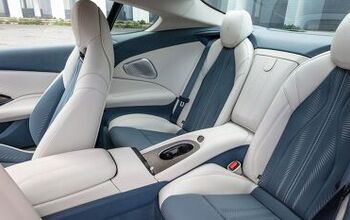The One Percent Solution
Amory Lovins makes his living studying energy use and efficiency. According to the physicist and cofounder of the Rocky Mountain Institute environmental think tank, the modern automobile uses just one percent of its energy to move its occupant hither and yon. The number is shockingly small, and it may point to big changes for future cars.
Lovins points out that a great deal of an automobile’s engine power does… nothing much. At idle, a car uses its fuel to power accessories and keep itself going. All of which take a friction-filled bite of its overall efficiency. In fact, Lovins reckons only about an eighth of a car’s fuel is burned to turn its wheels. Half of that simply heats up your tires and the air around the vehicle. When you depress the go-pedal, you’re using just six percent of your engine’s total output.
On average– we’re not talking about a Prius or Hummer here– less than 20% of the energy of gasoline is actually used to drive the wheels of the car. That means very little of the gas you bought moves you down the road. It’s like buying a twelve pack and taking one sip.
The numbers look absurd, but if you’ve been around cars long enough, you know they’re not completely ridiculous. You know not to touch the exhaust manifold after the engine’s been running. You know not to stand up in your buddy’s convertible. Combustion engines put out a lot of heat and the atmosphere is not nearly as pliable as it seemed when you were standing still. In every mechanical transaction, friction takes a vig.
Then there’s the weight. Basically, 75 percent of what your car’s doing is moving its own weight. Steel, glass and gas are heavy. The more weight you have to move, the more energy you need to overcome gravity and inertia.
It’s as tough to find fault with the physics as it is to accept the outcome. If you were getting one percent return on an investment, you’d move your money. If your employee worked five minutes a day, you’d hand him a box for his Happy Meal toys and mouse pad and change all the administrative passwords. And yet, we put up with one percent efficiency from our cars? Not for long. As the price of producing that single percentage point grows (in many senses), the pressure to improve our vehicles’ energy efficiency grows stronger.
Of course, physics is kind of nice ‘cause everything goes both ways. If three quarters of your fuel is spent on weight, shedding pounds gives you about a seven-fold energy return. Lower your drag and you can pick up some more. Fancy engines are another solution, but materials and design are where the really dramatic energy savings live.
For example, BMW has developed a process for mass-producing carbon fiber-reinforced plastics (CFP). CFP is up to 30 percent lighter than aluminum and 50 percent lighter than steel, without concession to strength. Although the cost of production and application currently relegates the technology to aeronautics and serious racing, new procedures have begun delivering the material to mainstream vehicles. OK, the M6 and M3 are not exactly what you’d call fleet cars, but it’s a start.
CFP is also easier to shape than its ferrous colleagues. Instead of pressing a hood and attaching hitches and hinges, a CFP hood can be extruded with all its doodads in place. Any manufacturer who could master mass production would see its vehicles’ number of parts– and related assembly time– plummet. CFP also offers designers the opportunity to use more complicated forms, to create shapes that can’t be [cost-effectively] hammered out of metal.
Reduced reliance on metal stamping would also lead to quicker refresh rates for styles, and more simultaneous choices. Seven different Scion TCs in the same model year. A WRX that screams I just graduated and one that whispers I was never here. Fins for some, no fins for others. Mass customization.
Greater control of vehicle design can also increase the slipperiness of vehicle, further improving efficiency and performance. Lovins believes a 66 mpg SUV is achievable, without compromising current space or driving dynamics. It could big, brutish, tow a small town and safer too boot. Americans can eat their cake and have it too.
Carbon fiber costs around $8.50 a pound, compared to $1 for the same amount of steel. Unless economies of scale can lower unit prices, it seems a hopeless mismatch. Think how much debate surrounds the commercial value of the current “hybrid premium.” If, however, you believe that oil will not dip below $70 a barrel, that global warming is not the liberal conspiracy that Mr. Limbaugh and his supporters suggest, or that a one percent return on your energy dollar is unacceptable, a little hike in sticker prices could represent a big bargain.
More by Michael Martineck
Latest Car Reviews
Read moreLatest Product Reviews
Read moreRecent Comments
- VoGhost Interesting comments. Back in reality, AV is already here, and the experience to date has been that AV is far safer than most drivers. But I guess your "news" didn't tell you that, for some reason.
- Doc423 Come try to take it, Pal. Environmental Whacko.
- 28-Cars-Later Mazda despite attractive styling has resale issues - 'Yota is always the answer.
- 28-Cars-Later Try again.
- Doc423 It's a flat turn, not banked, which makes it more difficult to negotiate, especially if you're travelling a little too fast.


































Comments
Join the conversation
Some insteresting stuff for the "chem-heads": www.ecotraffic.se/publikationer_eng.asp
One of the frustrations I have as a consumer is that I can't influence the car design process in any way other than not buying a particular model. Right now, the weight gains of some new models are a major turnoff for me. Ford F-150 regular cab SB MT V6 4615lbs! Acura TSX 4cyl MT small sedan 3257lbs! 3345lbs with auto. I guess that other consumers must value 5 star crash test ratings and the impression of quality that comes with more mass more than they value quick acceleration and good city cycle fuel economy. I wish I could pay more for the "more aluminum, less iron and steel, less mass" performance option to reduce the weight of non-structural parts of a car. I don't expect revolutionary changes with every design cycle, but 5-10% weight reduction vs. 5-10% weight increase would be nice.